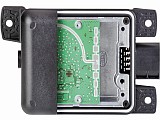- Login
- LOGIN-AREA
- Aftermarket Club
- Deutsch
Technology & Products / 18.08.2016
HELLA produces its ten-millionth 24 GHz radar sensor and continues its success story
Start of production for the fourth generation beginning in mid-201710/26/2016
10/26/2016
HELLA put its first generation of 24 GHz radar sensors into series production back in 2005. The sensor systems are ideal for applications that have since become standard functions, such as blind spot detection, lane change assistants and rear-facing parking assistance. To accomplish these tasks, the sensor records the speed, angle and distance information for objects in an area up to 70 meters away. Then it evaluates the information. Today, HELLA is by his own account the market leader in 24 GHz narrow-band sensors. 15 OEMs have chosen the company as their supplier, resulting in more than 120 vehicle series being outfitted with this radar technology at present. "We are continuously developing radar technology based on 24 GHz," says Carsten Roch, Head of Driver Assistance Systems at HELLA. "The fourth generation of 24 GHz radar is going into global production in mid-2017."
The fourth generation of radar sensors will offer enhanced safety functions. In addition to the standard functions mentioned above, the latest generation of radar will include features such as exit assist. This allows early detection of dangerous situations (such as a car passing by) and the passengers in the vehicle can be warned. But enhancing functions is not the only focus for the new sensor. HELLA is developing the 24 GHz radar sensors based on a modular platform approach, meaning development is in conjunction with 77 GHz radar sensors, which are also new. One thing that 77 GHz radar technology makes possible is scanning the area around the vehicle in detail, even nearby. This opens up the opportunity of developing more innovative safety and comfort functions. The new sensors are the result of collaboration with InnoSenT GmbH, which has been a partner of HELLA since 2005 and has been developing radar products exclusively for and with the company since June 2016. Thanks to the modular platform approach with a virtually identical sensor design and the use of the same standard operating software, automobile manufacturers can replace the sensors in a vehicle with minimal cost and effort. They also have the flexibility to adapt the driver assistance systems in use based on the requirements and requests from their customers. For deciding where the sensors are best positioned in the car, HELLA supports its customers with computer-assisted simulations that have been continuously developed and expanded over the years. "24 GHz and 77 GHz products are not mutually exclusive. The 24 GHz narrow-band technology is not subject to any regulatory limitations, allowing for use anywhere in the world. In addition, the technology's price advantage is of great interest for smaller vehicle segments," says Carsten Roch. The fourth generation of radar based on 24 GHz technology is letting HELLA continue on the path to its goal of making driver assistance systems available for the mass market as well.
2016
Press kits
Automechanika 2016
10/26/2016
Contact
Dr. Markus Richter
Company Spokesman
Rixbecker Str. 75
59552 Lippstadt, Germany
Tel.: +49 2941 38-7545
Fax: +49 2941 38-477545
Markus.Richter@hella.com
Company Spokesman
Rixbecker Str. 75
59552 Lippstadt, Germany
Tel.: +49 2941 38-7545
Fax: +49 2941 38-477545
Markus.Richter@hella.com
02/23/2017


